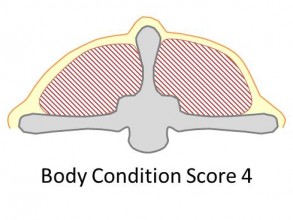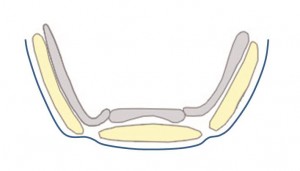Goat Diseases

The later stages of pregnancy and early lactation require a lot of energy from the mother and this must be met by feed intake or pregnancy toxaemia or ketosis may occur.
Pregnancy Toxaemia and Ketosis in Goats
Also known as Twin kid disease, Ketosis, Ketonaemia and Hypoglycaemia
Pregnancy toxaemia is a metabolic disorder of pregnant ruminants (pre-parturition) caused by abnormal metabolism of carbohydrates and fats, which occurs in the final stages of pregnancy. Ketosis (or ketonaemia) is also a metabolic disorder associated with fat and carbohydrate metabolism but occurs after kidding during the early lactation stages. Both conditions are closely link and associated with negative energy balance.
Although many animals are able to cope and recover from a negative energy balance by metabolising body fat albeit with a negative impact on productivity at the sub-clinical stage, some metabolise too much fat, become overwhelmed with the associated by-products (ketone bodies), and develop pregnancy toxaemia (before kidding) and ketosis (after kidding).
What is Negative Energy Balance (NEB)?

Negative energy balance in goats is a result of feed intake not meeting the high energy demands of late pregnancy and early lactation.
The final stages of pregnancy and the onset of milk production (lactation) requires a lot of energy, this high demand is usually met by feed intake and topped up by body reserves. If the (metabolisable) energy from feed intake and the body reserves is less than required for the foetus to grow or to produce milk – the body is in a Negative Energy Balance (NEB).
NEB is considered the normal in high yielding animals during early lactation, however stress can cause further reduction in feed intake and lead to the onset of sub-clinical or clinical ketosis. NEB a detrimental consequence of human selection for high yielding animals, hence the emerging trends in diary cattle and reduction in milk yield and gain in animal welfare.
Fat mobilisation
Due to low glucose levels in the blood, fatty acids and glycerol from ‘stores’ are oxidised to form Acetyl-CoA. However, the liver cannot cope with high levels of acetyl-CoA so it is converted into ketone bodies (including Beta-hydroxylbuterate, BHBA). These ketone bodies can be used by other tissues and muscles in the body, but if they cannot keep up, the ketones are excreted in milk and urine.
BHBA and other ketone bodies are found in blood, urine and milk of ruminants experiencing a period of negative energy balance (Herdt, 2000). In dairy goats blood BHBA concentration generally increases during late stages of pregnancy (Herdt, 2000).
Early detection of pregnancy toxaemia or ketosis by measurement of BHBA is useful as clinical pregnancy toxaemia usually has a poor rate of survival (Doré et al., 2013).
Risk factors for pregnancy toxaemia in goats
Risk factors for pregnancy toxaemia include carriage of multiple foetuses, age, and extreme body condition score (BCS), fat or thin (Rook, 2000). Obese animals carrying multiple foetuses are at highest risk to develop disease (Ermilio and Smith, 2011).
Clinical signs of pregnancy toxaemia are usually non-specific at the onset of disease and may include anorexia, isolation from herd mates, swollen lower limbs, tremors, recumbency, blindness, ataxia, coma and death (Brozos et al., 2011; Doré et al., 2015; Rook, 2000).
In dairy goats the final month of pregnancy is a critical period for the management of energy balance because approximately 60 – 80% of foetal growth occurs during this period, and because dry matter intake declines simultaneously (Rook, 2000).
Pregnancy toxaemia can be fatal in does and ewes if not diagnosed in a timely manner, therefore, early identification of goats at risk of developing pregnancy toxaemia increases the chances of recovery (Brozos et al., 2011; Rook, 2000).
Risk factors for ketosis in goats
As the energy requirements of does considerably increases with the onset of lactation, most does will develop mild or lactational ketosis (Pichler et al., 2014). Goats in early lactation loses excessive body weight if the feed intake quantity and quality is not adequate to meet the energy requirements of producing milk, hence animals are in negative energy balance (Matthews, 2009).
In dairy goats, clinical ketosis manifests predominantly in early lactation (Stelletta et al., 2008). Does carrying multiple foetuses, undernourished or overweight animals are likely to develop clinical ketosis (Brozos et al., 2011; Rook, 2000).
Clinical signs include anorexia, recumbency, lethargy, muscle spasm of the head and neck (opisthotonos), dropped head, convulsion, sweet smelling breath, apparent blindness, bloat, teeth grinding, and frothy salivation (Vasava et al., 2016).
Diagnosis for pregnancy toxaemia or ketosis
Characteristic biochemical patterns associated with pregnancy toxaemia in goats showed that there is a decreased level of glucose and calcium in the blood, and increased levels of ketone bodies (Vasava et al., 2016).
Increased concentration BHBA and/ or low blood glucose during the late stage of pregnancy and early lactation are associated with pregnancy toxaemia and ketosis. In dairy cows, dipsticks can be used to detect BHBA in urine or milk, however in goats, these semi-quantitative tests are not as accurate as blood tests.
Control and Prevention of Pregnancy Toxaemia and Ketosis
Prevention of pregnancy toxaemia and ketosis in goats is via nutritional management and identification of those animals at most risk. Feed intake should be monitored and adapted to meet the need of the doe. The feed ration will invariably be different for pregnant and lactating animals and therefore body condition scoring (see below) is a useful way to monitor and identify animals at risk (Harwood, 2016).
One of the guiding principles of sustainable livestock production is to feed high levels of roughage in the diet so as to promote good rumen digestion. However, as the doe progresses in the late stage of pregnancy, the energy density of the ration should increase to accommodate the inevitable reduction in dry matter intake. Anecdotally, there is evidence that in intensively reared small ruminants access to external paddocks and grazing during the late stage of pregnancy will contribute to reduce the onset of pregnancy toxaemia.
Over fatness should be avoided in pregnancy wherever possible. Over-feeding from mid-pregnancy onwards leads to excessive fat being laid down internally.
Body Condition Score for Goats
Treatment for Pregnancy Toxaemia

Avoiding over-eating during pregnancy is the best strategy in preventing pregnancy toxaemia or ketosis in goats.
Variability in the recovery rate from one study to another with the same treatments, but slightly different protocols and definitions of pregnancy toxaemia make it difficult to know what the ideal treatment should be, especially in severe cases. In general, once recumbency occurs the prognosis for recovery is poor. For this reason the focus should be on preventing the disease, and identifying those animals at higher risk (Doré et al., 2015).
A blood test can be carried out to check for elevated ketone bodies (BHBA). Mild cases may respond to nurture. A vet may administer glucose into a vein, or mild cases can be treated with shop bought ‘twin-lamb drench’. If the condition fails to respond, a caesarean may be necessary however the prognosis for doe and kids can be very poor (Harwood, 2006).
Early detection of sub-clinical ketosis followed by an efficacious treatment should help to minimise economic losses (Brozos et al., 2011; Rook, 2000; Sargison, 2007).
It is usually advisable to treat for hypocalcaemia also as this is often a complicating factor.
Good Practice Based on Current Knowledge
- Have an accurate knowledge of kidding dates so you can plan a feeding regime
- Avoid over feeding goats particularly from mid-pregnancy onwards
- Ensure does are not too fat at kidding
- Feed a low plane of nutrition 3-5 weeks before kidding, then moving to a high plane of nutrition in the final weeks of pregnancy to prepare for kidding and lactation. This should reduce the risk of pregnancy toxaemia and ketosis (Hardwood, 2006)
- Regular condition scoring in important at kidding and early lactation. Aim for a body condition score of 3.0 during pregnancy and 3.0 – 3.5 at kidding. Goats exceeding these scores should be identified and fed a poorer diet


 American English
American English














Comments are closed.